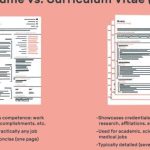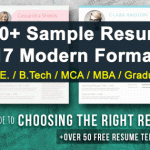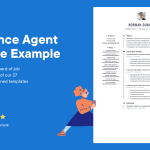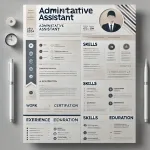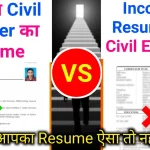The differences between a CV and a resume is crucial for job seekers across various fields. A CV offers a detailed overview of an individual’s academic and professional history, suitable for academic and research roles. In contrast, a resume provides a concise, targeted summary of skills and experiences tailored for specific job applications in various industries.
1. Definition and Purpose
1.1 Curriculum Vitae (CV)
A curriculum vitae, Latin for “course of life,” is an in-depth document that outlines an individual’s entire academic and professional history. It is primarily used in academia, research, and medicine, as well as in some international contexts. A CV is exhaustive, detailing all educational qualifications, research experiences, publications, presentations, awards, honors, and other academic accomplishments.
1.2 Resume
A resume, derived from the French word for “summary,” is a concise document that highlights an individual’s skills, experiences, and qualifications relevant to a specific job. Unlike a CV, a resume is tailored to each job application, emphasizing the most pertinent information and often constrained to one or two pages. Resumes are commonly used in business, industry, non-profits, and various other sectors.
2. Length and Detail
2.1 CV Length
CVs tend to be lengthy, often spanning several pages. The length is not fixed, as it grows with the individual’s career. It includes comprehensive details about one’s professional journey, with no strict page limit. Academics and researchers might have CVs that extend to 10 pages or more due to the inclusion of extensive lists of publications, conferences, and projects.
2.2 Resume Length
Resumes are typically short, with a standard length of one to two pages. The brevity is crucial as hiring managers often review many applications and need to quickly gauge the candidate’s suitability. Therefore, resumes are succinct, focusing on key achievements and experiences that are directly relevant to the job in question.
3. Content and Structure
3.1 CV Content
The content of a CV is extensive and detailed. Common sections include:
- Personal Information: Name, contact information, and sometimes a photograph.
- Professional Summary or Objective: A brief statement summarizing professional goals.
- Education: Detailed information about academic qualifications, including degrees, institutions, and dates attended.
- Research Experience: Descriptions of research projects, methodologies, and outcomes.
- Publications: A comprehensive list of published works, including books, journal articles, and conference papers.
- Presentations and Conferences: Details of presentations made at academic conferences and seminars.
- Work Experience: Academic and relevant professional roles, with detailed descriptions of responsibilities and achievements.
- Awards and Honors: Recognition received for academic and professional excellence.
- Grants and Fellowships: Information about funding received for research projects.
- Professional Affiliations: Membership in academic and professional organizations.
- Skills: Technical and soft skills pertinent to the academic or research field.
- References: Contact details of individuals who can provide professional references.
3.2 Resume Content
The content of a resume is more streamlined and focused on the job at hand. Common sections include:
- Contact Information: Name, phone number, email address, and sometimes a LinkedIn profile.
- Professional Summary or Objective: A concise statement highlighting career goals and key skills.
- Work Experience: Relevant job roles, focusing on accomplishments and responsibilities that align with the job being applied for.
- Education: Brief details of academic qualifications.
- Skills: A list of technical and soft skills pertinent to the job.
- Certifications and Licenses: Professional certifications and licenses relevant to the job.
- Awards and Honors: Notable achievements, if relevant to the job.
- Professional Affiliations: Memberships in professional organizations, if relevant.
- References: Often omitted or stated as “available upon request.”
4. Usage and Context
4.1 When to Use a CV
CVs are typically used in academic, research, and medical fields, as well as in certain international job markets. They are appropriate for:
- Academic Positions: Faculty roles, postdoctoral positions, and research fellowships.
- Research Applications: Grant applications, research proposals, and research-based roles.
- Medical Professions: Applications for medical residencies, fellowships, and clinical roles.
- International Jobs: Positions in countries where the CV format is the standard for job applications (e.g., Europe, Asia).
4.2 When to Use a Resume
Resumes are widely used in the business, industry, non-profit, and public sectors. They are appropriate for:
- Corporate Jobs: Positions in business, finance, marketing, and management.
- Technical Roles: Engineering, IT, and other technical fields where specific skills and experiences are crucial.
- Creative Industries: Roles in design, media, entertainment, and arts.
- Non-Profit and Government Jobs: Positions that require a broad range of skills and experiences but do not demand the detailed academic background of a CV.
- General Job Applications: Any job market where brevity and relevance are valued.
5. Customization and Adaptation
5.1 Customizing a CV
Customizing a CV involves emphasizing certain sections based on the job or academic opportunity. For instance, a candidate applying for a research-focused role might highlight their research projects and publications, while someone seeking a teaching position might emphasize their teaching experience and educational philosophy. However, the overall structure and comprehensive nature of a CV remain consistent.
5.2 Customizing a Resume
Resumes require more customization for each job application. This includes:
- Tailoring the Professional Summary: Aligning it with the job description and company goals.
- Highlighting Relevant Experience: Selecting the most pertinent job roles and achievements.
- Adjusting Skills Section: Emphasizing skills that match the job requirements.
- Using Keywords: Incorporating keywords from the job posting to pass through Applicant Tracking Systems (ATS).
6. Visual Presentation and Formatting
6.1 CV Formatting
CVs typically have a straightforward, academic layout. Key points include:
- Consistent Formatting: Uniform font style and size, clear headings, and bullet points.
- Detailed Sections: Each section is clearly labeled and organized.
- No Graphics or Color: Generally, CVs are black and white, focusing on content rather than design.
- Chronological Order: Education and work experience are often listed in reverse chronological order.
6.2 Resume Formatting
Resumes can be more creative in terms of design and layout. Key points include:
- Concise Layout: Use of headings, subheadings, and bullet points to ensure clarity.
- Professional Design: Incorporating subtle colors and design elements to make the document visually appealing.
- ATS-Friendly: Ensuring the resume can be read by Applicant Tracking Systems, avoiding complex formatting and graphics.
- Chronological or Functional Order: Depending on the candidate’s experience, resumes can be formatted chronologically (reverse order) or functionally (focusing on skills and experiences).
7. Digital and Online Presence
7.1 CV in the Digital Age
With the rise of digital platforms, many academics maintain an online CV or academic portfolio. This can include:
- Personal Websites: Hosting an online CV with links to publications, projects, and presentations.
- Academic Networks: Profiles on platforms like ResearchGate, Google Scholar, and ORCID.
- Institutional Pages: Faculty pages on university websites.
7.2 Resume in the Digital Age
Job seekers often complement their resumes with an online presence. This can include:
- LinkedIn Profiles: Comprehensive profiles that mirror and expand upon resume content.
- Personal Websites: Showcasing portfolios, especially for creative professionals.
- Professional Networks: Membership and profiles on industry-specific platforms.
8. Examples and Templates
8.1 CV Examples and Templates
Several online resources provide CV examples and templates tailored for different academic and research fields. These templates often include sections for publications, research experience, and academic achievements.
8.2 Resume Examples and Templates
Resume examples and templates are widely available, catering to various industries and job roles. These templates offer a range of designs, from classic to modern, ensuring job seekers can find a format that suits their style and the job they are applying for.
9. Common Mistakes to Avoid
9.1 CV Mistakes
- Overloading with Irrelevant Information: Including non-academic job experiences that do not add value.
- Poor Organization: Failing to structure sections clearly, making it difficult to read.
- Lack of Updates: Not regularly updating the CV with new accomplishments and experiences.
9.2 Resume Mistakes
- Being Too Generic: Not tailoring the resume to each job application.
- Including Unnecessary Information: Adding personal details like age, marital status, or photos, which are generally not needed in many countries.
- Errors and Typos: Failing to proofread, leading to mistakes that can harm the candidate’s credibility.
FAQ: Difference Between CV and Resume
1. What is a CV?
A CV, or curriculum vitae, is a detailed document that outlines an individual’s entire academic and professional history. It includes information about education, work experience, research, publications, presentations, awards, and other relevant accomplishments. CVs are primarily used in academic, research, and medical fields, as well as in certain international job markets.
2. What is a resume?
A resume is a concise document that highlights an individual’s skills, experiences, and qualifications relevant to a specific job. It is typically one to two pages long and is tailored for each job application. Resumes are commonly used in business, industry, non-profits, and various other sectors.
3. How long should a CV be?
A CV can be several pages long and has no strict page limit. The length depends on the individual’s career history and accomplishments. Academics and researchers, for example, may have CVs that extend to 10 pages or more.
4. How long should a resume be?
A resume is usually one to two pages long. The brevity is important as hiring managers often review many applications and need to quickly gauge the candidate’s suitability.
5. What are the key sections of a CV?
Common sections of a CV include:
- Personal Information
- Professional Summary or Objective
- Education
- Research Experience
- Publications
- Presentations and Conferences
- Work Experience
- Awards and Honors
- Grants and Fellowships
- Professional Affiliations
- Skills
- References
6. What are the key sections of a resume?
Common sections of a resume include:
- Contact Information
- Professional Summary or Objective
- Work Experience
- Education
- Skills
- Certifications and Licenses
- Awards and Honors (if relevant)
- Professional Affiliations (if relevant)
- References (often stated as “available upon request”)
7. When should I use a CV instead of a resume?
Use a CV for:
- Academic positions (faculty roles, postdoctoral positions, research fellowships)
- Research applications (grant applications, research proposals)
- Medical professions (residency applications, clinical roles)
- International jobs where the CV format is standard (e.g., Europe, Asia)
8. When should I use a resume instead of a CV?
Use a resume for:
- Corporate jobs (business, finance, marketing, management)
- Technical roles (engineering, IT, technical fields)
- Creative industries (design, media, entertainment, arts)
- Non-profit and government jobs
- General job applications where brevity and relevance are valued
9. How can I customize my CV for a job application?
Customize your CV by:
- Emphasizing certain sections based on the job or academic opportunity
- Highlighting relevant research projects, publications, and teaching experience
- Tailoring the professional summary to align with the job description
10. How can I customize my resume for a job application?
Customize your resume by:
- Tailoring the professional summary to align with the job description and company goals
- Highlighting relevant job roles and achievements
- Adjusting the skills section to match the job requirements
- Incorporating keywords from the job posting to pass through Applicant Tracking Systems (ATS)
11. Can I include graphics or color in my CV?
Generally, CVs are black and white and do not include graphics or color. They focus on content rather than design. However, certain creative fields may allow for more visually appealing formats.
12. Can I include graphics or color in my resume?
Yes, resumes can be more creative in terms of design and layout. Professional design elements and subtle use of color can make a resume visually appealing, as long as it remains ATS-friendly and easy to read.
13. What are common mistakes to avoid in a CV?
Avoid these mistakes in a CV:
- Overloading with irrelevant information
- Poor organization, making it difficult to read
- Failing to regularly update the CV with new accomplishments
14. What are common mistakes to avoid in a resume?
Avoid these mistakes in a resume:
- Being too generic and not tailoring it to each job application
- Including unnecessary personal details (age, marital status, photos)
- Errors and typos due to lack of proofreading
15. Should I include references in my CV or resume?
In a CV, references are often included, listing contact details of individuals who can provide professional references. In a resume, it is common to state “references available upon request” rather than listing them outright.
16. How do CVs and resumes differ internationally?
In some countries, the terms CV and resume are used interchangeably. However, in the U.S., a CV is distinct and used mainly for academic and research roles, while a resume is used for general job applications. In many European and Asian countries, the term CV is commonly used for all job applications, and it often combines elements of both a traditional CV and a resume.
17. How often should I update my CV or resume?
You should update your CV or resume regularly, ideally every six months or whenever you achieve a significant new accomplishment (such as a new job, project, publication, or certification). Keeping your documents current ensures you are always ready to apply for new opportunities.
18. What is an ATS, and why should I care about it for my resume?
An ATS, or Applicant Tracking System, is software used by employers to filter and rank job applications. Resumes should be ATS-friendly, meaning they should use standard formatting, avoid complex graphics, and include keywords from the job description to ensure they are not filtered out by the system.
19. Can I use the same CV or resume for different job applications?
While you can use a base version of your CV or resume, it’s important to tailor each application to the specific job. This involves customizing the professional summary, highlighting relevant experiences, and adjusting keywords to match the job description.
20. Where can I find examples and templates for CVs and resumes?
Many online resources offer CV and resume examples and templates. Websites like Indeed, LinkedIn, and various university career services provide templates tailored to different industries and job roles. These templates can help you structure your documents effectively and ensure you include all necessary information.
21. How can I ensure my CV or resume stands out to employers?
To make your CV or resume stand out:
- Tailor it specifically to the job application
- Use a clear, professional layout
- Highlight your most relevant and impressive achievements
- Use strong action verbs and quantify your accomplishments where possible
- Ensure there are no errors or typos
22. What should I do if I’m transitioning between industries and need a new CV or resume?
If you’re transitioning between industries, focus on transferable skills and relevant experiences. Tailor your professional summary to highlight your adaptability and eagerness to bring your skills to the new field. Emphasize any cross-industry experiences and be prepared to explain your career transition in your cover letter and during interviews.
Latest Posts
- Step-by-step guide to download and apply for jee mains admit card 202
- Comprehensive 2025 government holidays and recruitment details for job seekers
- JEE Mains Admit Card 2025: Your Step-by-Step Guide to Downloading the Hall Ticket
- Everything You Need to Know About 2025 Government Holidays Recruitment
- Comprehensive Guide to rrb d group recruitment 2025 – Eligibility, Vacancies, and Application
- Detailed guide to nps trust recruitment 2025 vacancies, eligibility and apply process
- Comprehensive guide to hpcl recruitment 2025 notification, vacancies, and application process
- ignou bed admission 2025 complete recruitment guide with eligibility and process
- Comprehensive Guide to Indian Army Agniveer Recruitment 2025 Notification and Jobs
- Everything You Must Know About CBSE Board Exams 2025 Changes & New Rules

